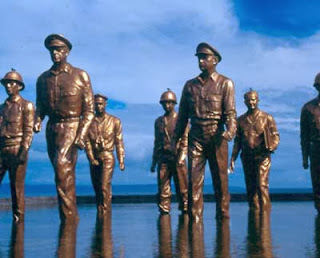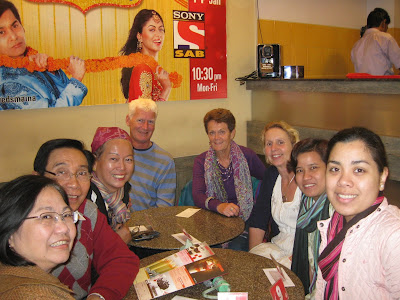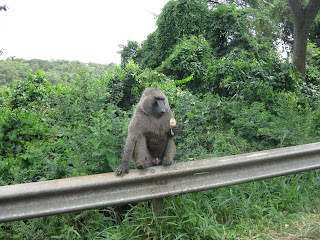
When I look at the footages
of the destruction and suffering brought by storm surge Haiyan, I wondered if
it was how Leyte looked like during World War II. History books tell us that the Battle of Leyte Gulf is one, if not THE greatest naval battle in the history of warfare.
An aunt told me that WWII
could be described as a drizzle compared with typhoon Haiyan or Yolanda (as she
is locally called). During the war, they
only had to dodge the bullets from the air, land and sea but they had shelters,
medical supplies, food to eat, and clothing to keep them warm.
Yolanda exposed Leytenos,
like myself, to a certain
nakedness. There was no place to hide.
Although I profess to “love
one another”, I love my brother firstly when the tragedy hit close to
home. I momentarily put aside concern
for my “neighbors”.
Home is Tanauan, the
2nd most hit town in Leyte, with recorded casualties to date of close
to 1,300 out of 5,600. It is 15 kilometers from Tacloban City.
For four days after the storm Tanauan had no communication lines. I had been continuously scrolling my phone address book and email contacts. I tried to recall each family in our neighborhood and searched for their names on Facebook hoping to get some information. It was like combing the beach and looking for a lost jewel.
For four days after the storm Tanauan had no communication lines. I had been continuously scrolling my phone address book and email contacts. I tried to recall each family in our neighborhood and searched for their names on Facebook hoping to get some information. It was like combing the beach and looking for a lost jewel.
Seeing for the first time a
TV footage of the destruction of my town and the dead bodies on the ground
without knowing if my kin was among them or not shook the strength that I was
trying to put up. In this day and age
when communication is instantaneous, no
news was bad news. It was the longest
and most torturous silence that I have experienced.


I kept vigil and when I see
food and water at home, I am overcome with guilt. I fasted, believing that I have saved it for someone
out there in Leyte. I
refrained from audio-visual entertainment because it was time to grieve. Whenever my fears crept in, I found comfort
by saying “Lord, Thy will be done.”


I volunteered to help in a
relief center hoping that one of those sacks will reach my brother or someone
who would share provisions with him. I saw how people felt good after making
donations in cash, kind, and
services. I wished I could assure them that
their kindness have reached the survivors and made a difference.
 |
| 10 kilos of rice to be included in blue pails |
Crying is good, but cry in
front of family; they will sincerely comfort
you and help you restore your faith.
There were also tears of
joy when friends whom I have not heard from in ages sent messages to say that
they remembered that I come from Leyte and worry about my safety. Words of sympathy even from non-FB friends
brought hope and encouragement. They rejoiced
with me when I told them that my brother and his family were safe.
As I was helping ship
provisions for Leyte I was told that a relative who was staying in an evacuation center where cellphone signal had been recently restored managed to make a difficult
journey to our hometown to search for my brother. In our brief conversation she assured me that
she personally talked to my brother and that he and his family were safe.
 |
| My car overloaded with relief goods |
Finally, a close family
relative traveled from Manila to Tanauan.
He was able to locate a spot where there was a phone signal and
with the remaining power in his mobile
phone, he handed it to my brother so I can hear his voice. My brother chose to stay in Tanauan and start
all over again.


As he starts to rebuild his
life, the first items on his shopping list were a radio, and a flashlight. I thought
that he needed more so I sent him a luggage containing all the essential items
that were on my packing checklist when I left to volunteer in Africa (including
carpentry tools and religious items for a new improvised altar at home). But most importantly, I got him a tarpaulin
to serve as a temporary roof to keep him and his family dry, in the meantime.
 |
| Medicines and prayer books for shipment |
Food for him and his family
comes from the relief goods and he now longs for fresh fish and
vegetables. Water comes from a nearby
well that is shared by the entire neighborhood. Power is still out but mobile phone signal
is back and his phone (which I sent with the luggage) is charged by
getting power from a friends’ motorcycle.
 |
| Contents of tumblers |
Now I know that a big part
of our lives is gone. But everything in
our destroyed house can be replaced; everything except for the cherished
mementos from our departed parents and brother.
Our biggest consolation is that our parents who met during WWII did not
have to bear witness to and suffer this great tragedy of 9 November 2013.
Typhoon Yolanda made me miserable
but it was a long lost relative also named Yolanda who brought me joy. She gave me the first news that my brother and his family were safe.


And to my brother, I hope the
lyrics of this song (He’s My Brother by the Hollies) bring you cheer.
The road is long
With many a winding turn
That leads us to who knows where
Who knows where
But I'm strong
Strong enough to carry him
He ain't heavy, he's my brother
So on we go
His welfare is of my concern
No burden is he to bear
We'll get there
For I know
He would not encumber me
He ain't heavy, he's my brother
If I'm laden at all
I'm laden with sadness
That everyone's heart
Isn't filled with the gladness
Of love for one another
It's a long, long road
From which there is no return
While we're on the way to there
Why not share
And the load
Doesn't weigh me down at all
He ain't heavy he's my brother
He's my brother
He ain't heavy, he's my brother
All photos in this post without captions were taken from Google, without permission. These are photos of Tanauan before Typhoon Yolanda.



















































